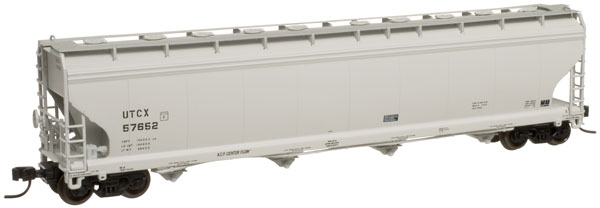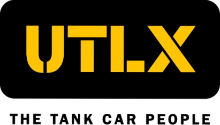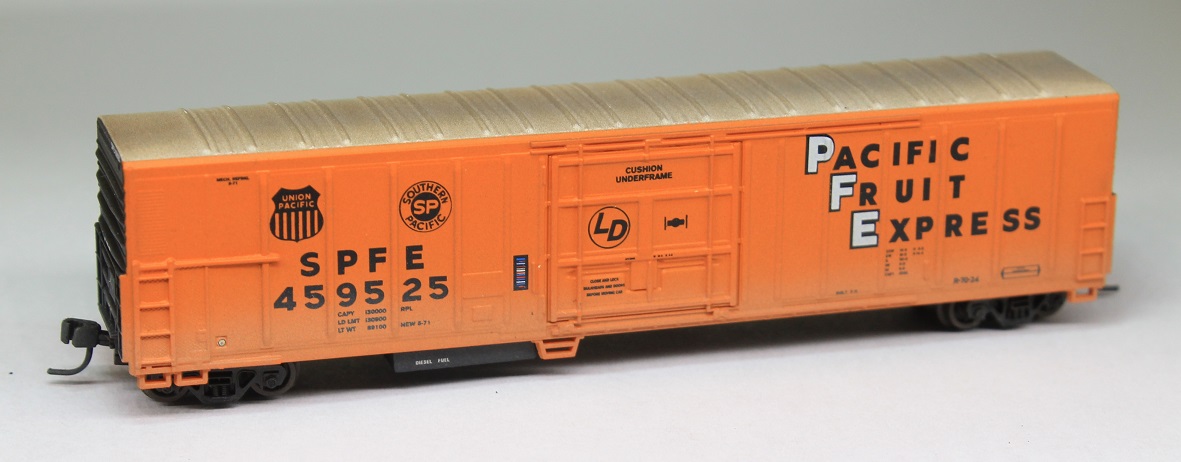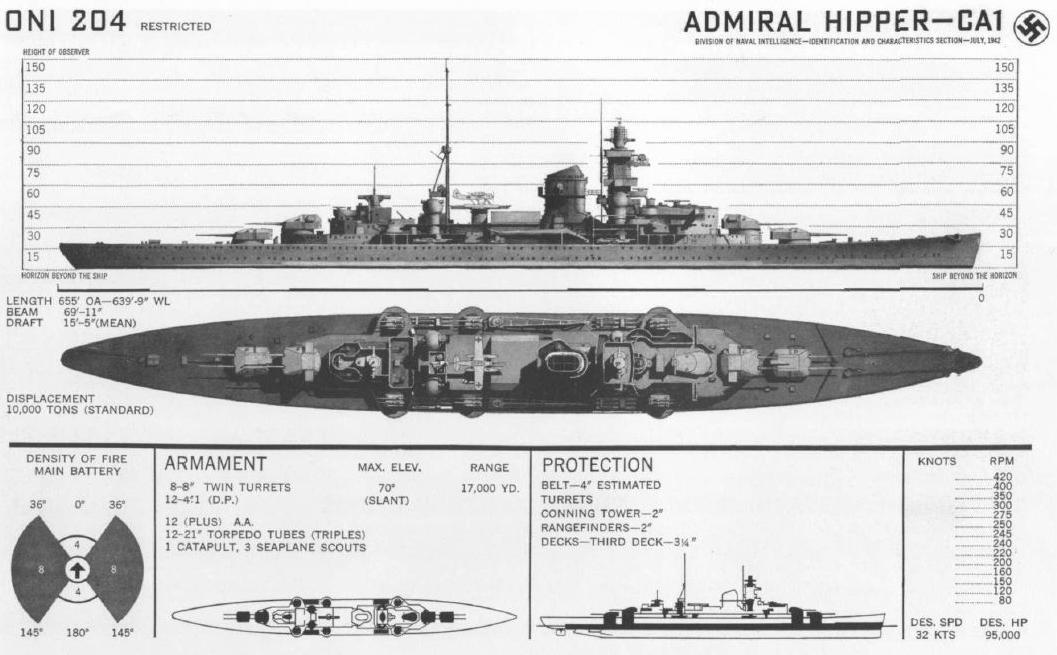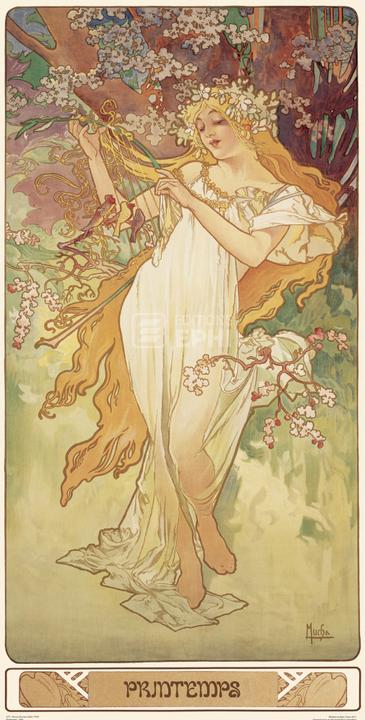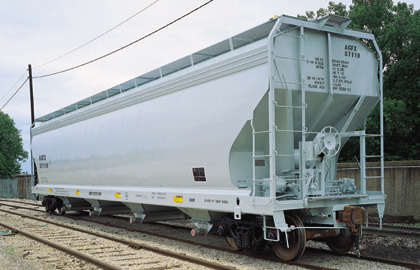Prototype History: Contemporary 2-bay covered hoppers, like ACF's Centerflows, were 100-ton cars designed to haul dense loads, like cement. Their larger 3 and 4-bay brethren, while usually still having 100 ton capacities, were designed for lighter-density loads, like grain or flour. Their sizes had to do with the fact that a low-density product like grain will "cube out" the cubic capacity of a smaller 2-bay car way before you hit the cars' tonnage rating. Conversely, load a 3 or 4-bay covered hopper to its cubic maximum with a dense product like cement, and you'll wind up with a seriously overloaded car tonnage wise. In short, keep the smaller 2-bay cars for heavy commodities, and keep the larger cars for lighter loads like grains, sugar, flour, etc.
Road Name History: Union Tank Car Company or UTLX (their best known reporting mark) is a railway equipment leasing company (and car maintenance / manufacturing) headquartered in metro Chicago, Illinois. As the name says, they specialise in tank cars, and covered hopper cars. As of September 2005, according to their site, they have about 80,000 cars in their fleet.
Union Tank Car Company was founded in 1866 by Captain Jacob J. Vandergrift, in response to the economic activities of John D. Rockefeller in the years leading up to his creation of Standard Oil. Vandergrift was involved in the conflicts in the oil regions of Western Pennsylvania in the 1860s?1870s. Eventually, Union Tank Car Company and Vandergrift's other holdings, which included pipeline and riverboat transport companies, merged with the company that later became Standard Oil. Rockefeller, once Captain Vandergrift's nemesis, made him Vice President of Standard Oil. The town of Vandergrift, Pennsylvania, built in 1895 by steel company president George G. McMurtry to house his workers, was named in Vandergrift's honor.
TransUnion was formed as a holding company in 1968 to hold Union Tank Car Company. TransUnion soon began began acquiring credit information and information management companies as a second major investment. The Marmon Group acquired TransUnion in 1981, spinning off the TransUnion name and the financial portion of the holding company to Madison Dearborn Partners in the 1990s.
Union Tank Car Company is still owned by Marmon, which in turn is now a 100% owned subsidiary of Berkshire Hathaway.
Union Tank Car Company was founded in 1866 by Captain Jacob J. Vandergrift, in response to the economic activities of John D. Rockefeller in the years leading up to his creation of Standard Oil. Vandergrift was involved in the conflicts in the oil regions of Western Pennsylvania in the 1860s?1870s. Eventually, Union Tank Car Company and Vandergrift's other holdings, which included pipeline and riverboat transport companies, merged with the company that later became Standard Oil. Rockefeller, once Captain Vandergrift's nemesis, made him Vice President of Standard Oil. The town of Vandergrift, Pennsylvania, built in 1895 by steel company president George G. McMurtry to house his workers, was named in Vandergrift's honor.
TransUnion was formed as a holding company in 1968 to hold Union Tank Car Company. TransUnion soon began began acquiring credit information and information management companies as a second major investment. The Marmon Group acquired TransUnion in 1981, spinning off the TransUnion name and the financial portion of the holding company to Madison Dearborn Partners in the 1990s.
Union Tank Car Company is still owned by Marmon, which in turn is now a 100% owned subsidiary of Berkshire Hathaway.
Brand/Importer Information: In 1924 Stephan Schaffan, Sr. founded the Atlas Tool Company in Newark, New Jersey. In 1933 his son, Stephan Schaffan, Jr., came to work for his father at the age of sixteen. Steve Jr. built model airplanes as a hobby and frequented a local hobby shop. Being an enterprising young man, he would often ask the owner if there was anything he could do to earn some extra spending money. Tired of listening to his requests, the hobby-store owner threw some model railroad track parts his way and said, "Here, see if you can improve on this".
In those days, railroad modelers had to assemble and build everything from scratch. Steve Jr. created a "switch kit" which sold so well, that the entire family worked on them in the basement at night, while doing business as usual in the machine shop during the day.
Subsequently, Steve Jr. engineered the stapling of rail to fiber track, along with inventing the first practical rail joiner and pre-assembled turnouts and flexible track. All of these products, and more, helped to popularize model railroading and assisted in the creation of a mass-market hobby. The budding entrepreneur quickly outgrew the limitations of a basement and small garage operation. Realizing they could actually make a living selling track and related products, Steve and his father had the first factory built in Hillside, New Jersey at 413 Florence Avenue in 1947. On September 30, 1949, the Atlas Tool Company was officially incorporated as a New Jersey company.
In 1985, Steve was honored posthumously for his inventions by the Model Railroad Industry Association and was inducted into the Model Railroad Industry Hall of Fame in Baltimore, Maryland. In addition, Steve was nominated and entered into the National Model Railroad Association Pioneers of Model Railroading in 1995.
In the early 1990s, the Atlas Tool Company changed its name to Atlas Model Railroad Company, Inc.
In those days, railroad modelers had to assemble and build everything from scratch. Steve Jr. created a "switch kit" which sold so well, that the entire family worked on them in the basement at night, while doing business as usual in the machine shop during the day.
Subsequently, Steve Jr. engineered the stapling of rail to fiber track, along with inventing the first practical rail joiner and pre-assembled turnouts and flexible track. All of these products, and more, helped to popularize model railroading and assisted in the creation of a mass-market hobby. The budding entrepreneur quickly outgrew the limitations of a basement and small garage operation. Realizing they could actually make a living selling track and related products, Steve and his father had the first factory built in Hillside, New Jersey at 413 Florence Avenue in 1947. On September 30, 1949, the Atlas Tool Company was officially incorporated as a New Jersey company.
In 1985, Steve was honored posthumously for his inventions by the Model Railroad Industry Association and was inducted into the Model Railroad Industry Hall of Fame in Baltimore, Maryland. In addition, Steve was nominated and entered into the National Model Railroad Association Pioneers of Model Railroading in 1995.
In the early 1990s, the Atlas Tool Company changed its name to Atlas Model Railroad Company, Inc.
Item created by: James on 2017-01-15 17:03:01
If you see errors or missing data in this entry, please feel free to log in and edit it. Anyone with a Gmail account can log in instantly.
If you see errors or missing data in this entry, please feel free to log in and edit it. Anyone with a Gmail account can log in instantly.


